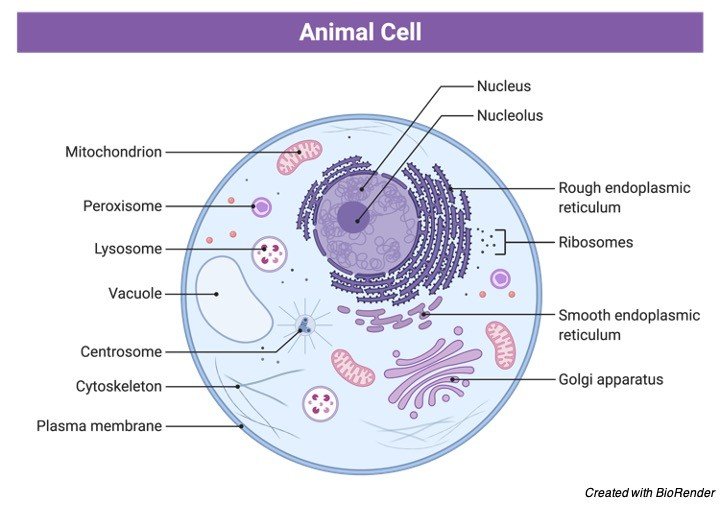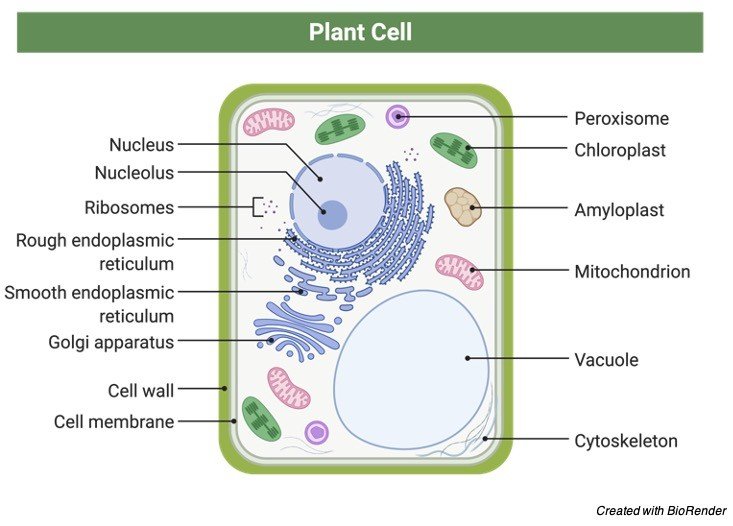Table of Contents
Eukaryotic Cell Definition
Eukaryotes originates from a Greek word; “eu” meaning good, “well” meaning true and “kauon meaning nut. The basic and fundamental unit of life is the cell, as living entities are comprised of cell. Microorganism are divided into Prokaryotes and Eukaryotes. Organism that do not possess nucleus and lack organelles are called prokaryotes. Eukaryotic cells are those who contains nucleus as well as the organelles. Example of prokaryotes are Archaea and Eubacteria. Eukaryotic organism examples are Algae, Fungi, Plants, Protists and Animals.
What is a Eukaryotic Cell?
Eukaryotes contain a nucleus, which is a huge organelle containing the genetic information. However not all eukaryotes possess nucleus, some of them contain nucleus but loses it for other function such as mammalian red blood cells, have attraction towards the respiratory gases and thus when they mature, are ready to lose their nucleus.
Labelled Animal Cell Diagram

Eukaryotic cells which contain nucleus are called nucleated whereas those who don’t possess nucleus are called anucleated. The DNA found in the nucleus has various function such as metabolism, growth, reproduction, homeostasis, differentiation and death. Thus, the DNA has various functions, it needs to be protected and is encapsulated by another layer surrounding the nucleus, it is called as nuclear envelope, which is double jacketed and separating the outer and the inside content. Although it does have pores on the surface so that molecules can come in and leave after their function is over. After the genetic information is copied by the mRNA and further hands it over to ribosomes, for protein translation.
Labelled Plant Cell Diagram

To the ribosomes is the endoplasmic reticulum attached. Ribosomes are found in both prokaryotes as well as eukaryotes, however they differ in their subunit. Eukaryotic cell has various organelles such as Mitochondria, Endosomes, Golgi apparatus, Endoplasmic Reticulum, Vacuoles, Lysosomes and Cytoskeleton. The function of Endoplasmic reticulum is to clear the drug, metabolism of carbohydrate and synthesis of biomolecules. Glycosylation, lipid transportation within cell, lysosomes arrival and packaging various molecules are functions of Golgi apparatus.
The powerhouse of cell is the mitochondria which will provide energy for various process. Plastid example chloroplast which produces and stores food, as they contain chlorophyll which helps in carrying out photosynthesis. The shape of the cell is maintained by the cytoskeleton. The unwanted components are thrown and the reusable ones are recycled by lysosomes.
For digestion, excretion, secretion and storage inside the cell vacuoles are important. Cytoplasm contains cytosol made up of proteins, ions and water. Apart from the DNA present in the nucleus, there are DNA found in the mitochondria as well as chloroplast. They carry out various metabolic functions.
Chloroplast DNA is not found in all types of eukaryotic cell as only plants and algae possess chloroplast. Plants possess cell wall which protect them from the outer environment and provides rigidity and shape. The cell wall is surrounded by cell membrane, which is a barrier separating outer contents from the inside. As animal cells do not contain cell wall, they are more flexible.
Type of Eukaryotic Cells
Eukaryotic cells can be of two types; Unicellular eukaryotic and multicellular eukaryotic. Examples of unicellular eukaryotic are Protists. Examples of multicellular eukaryotes are fungi, plant and animals.
Eukaryotic Cells Examples
It includes plants, animals, fungi and protist. These organism contain various structures in which various organelles are placed such as mitochondria, vacuole, lysosome, endoplamic reticulum and etc.
Evolutionary Origin
From the prokaryotes, the eukaryotes have emerged is what the Endosymbiotic theory states. This is said because the prokaryotic cell resembles the eukaryotes in terms of organelles and various functions that they carry out. However, it further states that prokaryotes have evolved into eukaryotes. Thus, forming different kingdoms such as Plantae, Animalia, Protist and Fungi.
Eukaryotic Cells Citations
- The Roles of Signaling in Cytoskeletal Changes, Random Movement, Direction-Sensing and Polarization of Eukaryotic Cells. Cells . 2020 Jun 10;9(6):1437.
- The functional role of polyamines in eukaryotic cells. Int J Biochem Cell Biol . 2019 Feb;107:104-115.
- Protein Synthesis Initiation in Eukaryotic Cells. Cold Spring Harb Perspect Biol . 2018 Dec 3;10(12):a033092.
- Cell cycle control across the eukaryotic kingdom. Trends Cell Biol . 2013 Jul;23(7):345-56.
Share












